Panasonic WV-SPN310, WV-SPN311 User Manual

Operating Instructions
Network Camera
Model No. WV-SPN3 Series
WV-SPN311
This manual covers the models: WV-SPN3 Series(WV-SPN311,WV-SPN310)
Before attempting to connect or operate this product, please read these instructions carefully and save this manual for future use.
The model number is abbreviated in some descriptions in this manual.

Preface
Preface
About the user manuals
There are 3 sets of operating instructions as follows.
•Operating Instructions (this document): Explains how to perform the settings and how to operate this camera.
•Important Information: Provides information about the cautions required for safely using and installing this camera.
•Installation Guide: Explains how to install and connect devices.
The screens used in these operating instructions show the case of WV-SPN311. Depending on the model used, the screens shown in the explanations may differ to the actual camera screens.
About notations
The following notations are used when describing the functions limited for specified models. The functions without the notations are supported by all models.
 : The functions with this notation are available when using the model WV-SPN311.
: The functions with this notation are available when using the model WV-SPN311.  : The functions with this notation are available when using the model WV-SPN310.
: The functions with this notation are available when using the model WV-SPN310.
Trademarks and registered trademarks
•Microsoft, Windows, Windows Vista, Windows Media, Internet Explorer, and ActiveX are either registered trademarks or trademarks of Microsoft Corporation in the United States and/or other countries.
•Microsoft product screen shot(s) reprinted with permission from Microsoft Corporation.
•iPad, iPhone, iPod touch, and QuickTime are trademarks of Apple Inc., registered in the U.S. and other countries.
•Android is a trademark of Google Inc.
•Firefox is a registered trademark of the Mozilla Foundation.
•SDXC Logo is a trademark of SD-3C, LLC.
•All other trademarks identified herein are the property of their respective owners.
Abbreviations
The following abbreviations are used in these operating instructions. Microsoft® Windows® 8.1 is described as Windows 8.1.
Microsoft® Windows® 8 is described as Windows 8. Microsoft® Windows® 7 is described as Windows 7. Microsoft® Windows Vista® is described as Windows Vista.
Windows® Internet Explorer® 11, Windows® Internet Explorer® 10, Windows® Internet Explorer® 9, Windows® Internet Explorer® 8 and Windows® Internet Explorer® 7 are described as Internet Explorer. SDXC/SDHC/SD memory card is described as SD card or SD memory card.
Universal Plug and Play is described as UPnP™.
2Operating Instructions

Preface
Viewer software
It is necessary to install the viewer software “Network Camera View 4S” (ActiveX®) to display images on a PC. This software can be installed directly from the camera or by selecting the [Install] button next to [Viewer Software] on the menu of the CD-ROM provided, and then following the on-screen instructions.
IMPORTANT
•The default setting of “Automatic installation” is “On”. Follow the instructions on page 214 when the message is displayed on the information bar of the browser.
•When the “Live” page is displayed for the first time, the install wizard of the ActiveX control required to display images from the camera will be displayed. Follow the instructions of the wizard.
•When the install wizard is displayed again even after completing the installation of the ActiveX, restart the PC.
•The viewer software used on each PC should be licensed individually. The number of installations of the viewer software from the camera can be checked on the [Upgrade] tab of the “Maintenance” page (®page 189). Refer to your dealer for the software licensing.
Operating Instructions |
3 |
|
|

Table of Contents
Table of Contents
1 Monitor images on a PC .......................................................................... |
7 |
|
1.1 |
Monitor images from a single camera ............................................................................. |
7 |
1.2 |
About the “Live” page ...................................................................................................... |
9 |
1.3 |
Monitor cropping images ............................................................................................... |
13 |
1.4 |
Monitor images from multiple cameras ........................................................................ |
16 |
2 |
Monitor images on a cellular phone/mobile terminal |
.........................17 |
2.1 |
Monitor images on a cellular phone .............................................................................. |
17 |
2.2 |
Monitor images on a mobile terminal ............................................................................ |
19 |
3 |
Record images on the SD memory card manually ............................. |
24 |
4 |
Action at an alarm occurrence .............................................................. |
26 |
4.1 |
Alarm type ........................................................................................................................ |
26 |
4.2 |
Action at an alarm occurrence ....................................................................................... |
26 |
5 |
Transmit images onto an FTP server ................................................... |
28 |
5.1Transmit an alarm image at an alarm occurrence (Alarm image
transmission) |
...................................................................................................................28 |
5.2Transmit images at a designated interval or period (FTP periodic image
transmission) |
...................................................................................................................28 |
5.3Save images on the SD memory card when images fail to transmit using the FTP
|
periodic image transmission function .......................................................................... |
29 |
6 |
Display the log list ................................................................................. |
30 |
7 |
Playback of images on the SD memory card ...................................... |
34 |
7.1Playback “JPEG(1)”/“JPEG(2)”/“JPEG(3)” images saved to the SD memory
card |
...................................................................................................................................34 |
7.2Playback “H.264(1)”/“H.264(2)”/“H.264(3)”/“H.264(4)” images saved to the SD
|
memory card .................................................................................................................... |
37 |
8 About the network security ................................................................... |
40 |
|
8.1 |
Equipped security functions .......................................................................................... |
40 |
9 Display the setup menu from a PC ....................................................... |
41 |
|
9.1 |
How to display the setup menu ..................................................................................... |
41 |
9.2 |
How to operate the setup menu ..................................................................................... |
43 |
9.3 |
About the setup menu window ...................................................................................... |
45 |
10 Configure the basic settings of the camera [Basic] ........................... |
47 |
|
10.1 |
Configure the basic settings [Basic] ............................................................................. |
47 |
10.2 |
Configure the Internet settings [Internet] ..................................................................... |
51 |
10.3 |
Configure the settings relating to the SD memory card [SD memory card] .............. |
53 |
10.4 |
Configure the settings relating to alteration detection [Alteration detection] .......... |
61 |
10.5 |
How to configure alteration detection settings ............................................................ |
63 |
10.5.1 Generation of the CRT key (encryption key) .................................................................. |
63 |
|
10.5.2 Generation of the self-signed certificate (security certificate) ......................................... |
64 |
|
10.5.3 Generation of CSR (Certificate Signing Request) .......................................................... |
66 |
|
10.5.4 Installation of the certificate issued by CA ...................................................................... |
68 |
|
10.5.5 Configuration of alteration detection ............................................................................... |
69 |
|
4Operating Instructions

Table of Contents
10.6Access copy images saved on the SD memory card onto the PC [SD memory card
|
images] ............................................................................................................................. |
70 |
10.7 |
Configure the directory of the PC that images will be downloaded to [Log] ............ |
81 |
11 Configure the settings relating to images and audio [Image/ |
|
|
Audio] ...................................................................................................... |
83 |
|
11.1 |
Configure the settings relating to the image capture mode [JPEG/H.264] ................ |
83 |
11.2 |
Configure the settings relating to JPEG images [JPEG/H.264] .................................. |
84 |
11.3 |
Configure the settings relating to H.264 images [JPEG/H.264] .................................. |
86 |
11.4Configure the settings relating to image adjust, zoom/focus, privacy zone, VIQS, and
|
lens distortion compensation [Image quality] .............................................................. |
91 |
11.4.1 |
Configure the settings relating to image quality (“Image adjust” setup menu) ............... |
92 |
11.4.2 |
Set mask areas .............................................................................................................. |
99 |
11.5 |
Back focus setting (“Back focus” setup menu) (WV-SPN311) ................................. |
102 |
11.6 |
Adjust the angular field of view using the extra optical zoom function .................. |
103 |
11.7Configure the settings relating to the privacy zone (“Privacy zone” setup
|
menu) ............................................................................................................................. |
104 |
11.8 |
Configure the VIQS setting .......................................................................................... |
106 |
11.9 |
Configure the VIQS area ............................................................................................... |
108 |
11.10 |
Configure the settings relating to lens distortion compensation ............................ |
110 |
11.11 |
Configure the settings relating to audio [Audio] ....................................................... |
111 |
12 Configure the multi-screen settings [Multi-screen] .......................... |
114 |
|
13 Configure the alarm settings [Alarm] ................................................. |
116 |
|
13.1 |
Configure the settings relating to the alarm action [Alarm] ..................................... |
116 |
13.2 |
Configure the settings relating to the alarm output terminal [Alarm] ...................... |
118 |
13.3 |
Change the AUX name [Alarm] .................................................................................... |
119 |
13.4Configure the settings relating to the camera action on alarm occurrence
|
[Alarm] ............................................................................................................................ |
119 |
13.4.1 |
Configure settings relating to image quality on alarm action ........................................ |
120 |
13.4.2 |
Configure settings relating to alarm E-mail notifications .............................................. |
121 |
13.4.3 |
Configure settings relating to FTP transmissions of alarm images .............................. |
122 |
13.4.4Configure settings relating to recording to an SD memory card when an alarm
occurs |
...........................................................................................................................123 |
13.4.5Configure settings relating to Panasonic alarm protocol notification when an alarm
|
occurs ........................................................................................................................... |
124 |
13.4.6 Configure settings relating to HTTP alarm notification when an alarm occurs ............. |
125 |
|
13.5 |
Configure the VMD settings [VMD area] ..................................................................... |
125 |
13.5.1 Set the VMD areas [VMD area] .................................................................................... |
127 |
|
13.6 |
Configure the settings relating to the audio detection [Audio detection] ............... |
129 |
13.7 |
Configuration of the settings relating to alarm notification [Notification] .............. |
131 |
13.7.1 Configure the settings relating to Panasonic alarm protocol ........................................ |
132 |
|
13.7.2 Configure the settings relating to HTTP alarm notification ........................................... |
134 |
|
14 Configure the settings related to advanced view [Advanced |
|
|
view] ...................................................................................................... |
136 |
|
14.1 |
Configure the settings relating to cropping [Cropping] ............................................ |
136 |
15 Configure the settings relating to the authentication [User |
|
|
mng.] ..................................................................................................... |
139 |
|
15.1 |
Configure the settings relating to the user authentication [User auth.] .................. |
139 |
15.2 |
Configure the settings relating to the host authentication [Host auth.] .................. |
140 |
15.3 |
Configure the settings relating to the priority stream [System] ............................... |
141 |
Operating Instructions |
5 |
|
|

Table of Contents
16 Configuring the network settings [Network] ..................................... |
144 |
|
16.1 |
Configure the network settings [Network] .................................................................. |
144 |
16.2 |
Configure advanced network settings [Advanced] ................................................... |
148 |
16.2.1 Configure the settings related to sending E-mails ........................................................ |
149 |
|
16.2.2 Configure the settings related to FTP transmission ..................................................... |
152 |
|
16.2.3 Configure the settings relating to the NTP server ........................................................ |
155 |
|
16.2.4 Configure the UPnP settings ........................................................................................ |
157 |
|
16.2.5 Configure the HTTPS settings ...................................................................................... |
158 |
|
16.2.6 Configure the settings relating to DDNS ...................................................................... |
160 |
|
16.2.7 Configure the settings relating to SNMP ...................................................................... |
160 |
|
16.2.8 Configure the Diffserv settings ..................................................................................... |
161 |
|
16.3 |
How to configure HTTPS settings ............................................................................... |
162 |
16.3.1 Generation of the CRT key (SSL encryption key) ........................................................ |
163 |
|
16.3.2 Generation of the self-signed certificate (security certificate) ....................................... |
164 |
|
16.3.3 Generation of CSR (Certificate Signing Request) ........................................................ |
166 |
|
16.3.4 Installation of the server certificate ............................................................................... |
167 |
|
16.3.5 Configuration of the connection protocol ...................................................................... |
168 |
|
16.4 |
Access the camera using the HTTPS protocol .......................................................... |
169 |
16.4.1 Install the security certificate ........................................................................................ |
169 |
|
16.5 |
How to configure the settings relating to DDNS ........................................................ |
176 |
16.5.1 Configuration of the DDNS service (Example of the “Viewnetcam.com” service) ........ |
177 |
|
16.5.2 When using the “Viewnetcam.com” service ................................................................. |
178 |
|
16.5.3 Procedure to register information for the “Viewnetcam.com” service ........................... |
179 |
|
16.5.4 Checking the information registered for the “Viewnetcam.com” service ...................... |
180 |
|
16.5.5 When using “Dynamic DNS Update” ............................................................................ |
180 |
|
16.5.6 When using “Dynamic DNS Update(DHCP)” ............................................................... |
181 |
|
17 Configure the settings relating to the schedules [Schedule] .......... |
182 |
|
17.1 |
How to set the schedules ............................................................................................. |
185 |
17.2 |
How to delete the set schedule .................................................................................... |
187 |
18 Maintenance of the camera [Maintenance] ........................................ |
189 |
|
18.1 |
Check the system log [System log] ............................................................................. |
189 |
18.2 |
Upgrade the firmware [Upgrade] ................................................................................. |
189 |
18.3 |
Check the status [Status] ............................................................................................. |
191 |
18.4 |
Reset the settings/Reboot the camera [Default reset] ............................................... |
192 |
18.5 |
Settings data/backing up or restoring logs [Data] ..................................................... |
193 |
19 Using the CD-ROM ............................................................................... |
195 |
|
19.1 |
About the CD launcher ................................................................................................. |
195 |
19.2 |
Installing Panasonic “IP Setting Software” ................................................................ |
196 |
19.3 |
Installing the manuals .................................................................................................. |
197 |
19.4 |
Installing the Viewer software ...................................................................................... |
197 |
19.5Configure the network settings of the camera using the Panasonic “IP Setting
|
Software” ....................................................................................................................... |
198 |
20 |
About the displayed system log ......................................................... |
201 |
21 |
Troubleshooting ................................................................................... |
206 |
22 |
Directory structure of drive B ............................................................. |
216 |
6Operating Instructions

1 Monitor images on a PC
1 Monitor images on a PC
The following are descriptions of how to monitor images from the camera on a PC.
1.1 Monitor images from a single camera
1.Start up the web browser.
2.Enter the IP address designated using the Panasonic “IP Setting Software” in the address box of the browser.
•Example when entering an IPv4 address: http://URL registered using IPv4 address http://192.168.0.10/
•Example when entering an IPv6 address: http://[URL registered using IPv6 address] http://[2001:db8::10]/
<Example of IPv4 access>
<Example of IPv6 access>
IMPORTANT
•When the HTTP port number is changed from “80”, enter “http://IP address of the camera + : (colon) + port number” in the address box of the browser. (Example: http://192.168.0.11:8080)
•When the PC is in a local network, configure the proxy server setting of the web browser (under [Internet Options...] under [Tools] of the menu bar) to bypass the proxy server for the local address.
Note
•Refer to page 169 for further information about the case in which “HTTPS” is selected for “HTTPS” - “Connection” on the [Advanced] tab of the “Network” page (®page 144).
Operating Instructions |
7 |
|
|

1 Monitor images on a PC
3.Press the [Enter] key on the keyboard.
→ The “Live” page will be displayed. Refer to page 9 for further information about the “Live” page.
When “On” is selected for “User auth.”, the authentication window will be displayed before displaying live images for the user name and password entries. The default user name and password are as follows. User name: admin
Password: 12345
IMPORTANT
•To enhance the security, change the password for the user name “admin”. It is recommended to change this password periodically.
•When displaying multiple H.264 images on a PC, images may not be displayed depending on the performance of the PC.
Note
•The maximum number of concurrent access user is 14 including users who is receiving H.264 images and users who are receiving JPEG images. Depending on the set values for “Bandwidth control(bit rate)” and “Max bit rate (per client)”, the maximum concurrent access number may be 14 or less users. When 14 users are concurrently accessing, the access limit message will be displayed for users who subsequently attempt to access. When “Multicast” is selected for “Transmission type” of “H.264”, only the first user who accessed to monitor H.264 images will be included in the maximum number. The second and subsequent users who are monitoring H.264 images will not be included in the maximum number.
•When “On” is selected for “H.264 transmission” (®page 86), H.264 images will be displayed. When “Off” is selected, a JPEG image will be displayed. It is possible to display a JPEG image even when “On” is selected for “H.264 transmission”. In this case, the refresh interval of JPEG images will be limited to 5 fps.
•The refresh interval may become longer depending on a network environment, PC performance, photographic subject, access traffic, etc.
<Refresh interval of JPEG images>
When “On” is selected for “H.264 transmission” max. 5fps
When “Off” is selected for “H.264 transmission” max. 30fps
8Operating Instructions
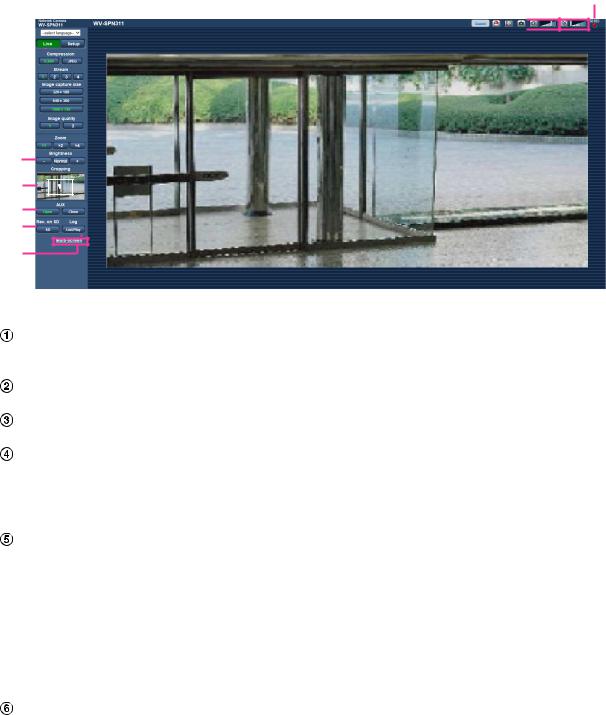
|
|
|
|
|
|
|
|
|
|
|
|
|
|
|
|
|
|
|
1 Monitor images on a PC |
|||||||
|
|
|
|
|
|
|
|
|
|
|||||||||||||||||
1.2 About the “Live” page |
|
|
|
|
|
|
|
|
|
|||||||||||||||||
|
|
|
|
|
|
|
|
|
|
|
|
|
|
|
|
O |
P QRS T U V |
|||||||||
A |
|
|
|
|
|
|
|
|
|
|
|
|
|
|
|
|
|
|
|
|
|
|
|
|
|
|
B |
|
|
|
|
|
|
|
|
|
|
|
|
|
|
|
|
|
|
|
|
|
|||||
|
|
|
|
|
|
|
|
|
|
|
|
|
|
|
||||||||||||
|
|
|
|
|
|
|
|
|
|
|
|
|
|
|
|
|
|
|
|
|
||||||
C |
|
|
|
|
|
|
|
|
|
|
|
|
|
|
|
|
|
|
|
|
||||||
|
|
|
|
|
|
|
|
|
|
|
|
|||||||||||||||
D |
|
|
|
|
|
|
|
|
|
|
|
|
|
|
|
|
|
|
|
|
|
|||||
|
|
|
|
|
|
|
|
|
|
|
|
|
|
|
|
|
|
|
|
|
||||||
E |
|
|
|
|
|
|
|
|
|
|
|
|
|
|
|
|
|
|
|
|||||||
|
|
|
|
|
|
|
|
|
|
|
|
|
|
|
|
|
|
|
|
|
||||||
F |
|
|
|
|
|
|
|
|
|
|
|
|
|
|
|
|
|
|
|
|||||||
|
|
|
|
|
|
|
|
|
|
|
||||||||||||||||
G |
|
|
|
|
|
|
|
|
|
|
|
|
|
|
|
|
|
|
||||||||
|
|
|
|
|
|
|
|
|
|
|
|
|
|
|
|
|
|
|||||||||
|
|
|
|
|
|
|
|
|
|
|||||||||||||||||
H |
|
|
|
|
|
|
|
|
|
|
|
|
|
|
|
|
|
|
W |
|||||||
|
|
|
|
|
|
|
|
|
|
|||||||||||||||||
I |
|
|
|
|
|
|
|
|
|
|
|
|
|
|
||||||||||||
J |
1 |
|
|
|
|
|
|
|
|
|
|
|
|
|||||||||||||
|
|
|
|
|
|
|
|
|
|
|
|
|
|
|
|
|||||||||||
K |
|
|
|
|
|
|
|
|
|
|
|
|
|
|
||||||||||||
L |
|
|
|
|
|
|
|
|
|
|
|
|
|
|||||||||||||
M |
|
|
|
|
|
|
|
|
|
|
|
|
|
|
|
|||||||||||
|
|
|
|
|
|
|
|
|
|
|
|
|
|
|
||||||||||||
N |
|
|
|
|
|
|
|
|
|
|||||||||||||||||
[select language] pull-down-menu
The camera’s display language can be selected. The default language can be set in the [Language] in the [Basic] settings. (®page 47)
[Setup] button*1
Displays the setup menu. The button will turn green and the setup menu will be displayed.
[Live] button
Display the “Live” page. The button will turn green and the “Live” page will be displayed.
[Compression] buttons
•[H.264] button: The letters “H.264” on the button will turn green and an H.264 image will be displayed. When “On” is selected for “H.264 transmission” of “H.264(1)”, “H.264(2)”, “H.264(3)”, “H.264(4)”, the [H.264] button will be displayed. (®page 86)
•[JPEG] button: The letters “JPEG” on the button will turn green and JPEG image will be displayed.
[Stream] buttons
These buttons will be displayed only when an H.264 image is displayed.
•[1] button: The letter “1” will turn green and images in the main area will be displayed in accordance with the setting of “H.264(1)”. (®page 86)
•[2] button: The letter “2” will turn green and images in the main area will be displayed in accordance with the setting of “H.264(2)”. (®page 86)
•[3] button: The letter “3” will turn green and images in the main area will be displayed in accordance with the setting of “H.264(3)”. (®page 86)
•[4] button: The letter “4” will turn green and images in the main area will be displayed in accordance
with the setting of “H.264(4)”. (®page 86)
[Image capture size] buttons
These buttons will be displayed only when a JPEG image is displayed.
Operating Instructions |
9 |
|
|

1 Monitor images on a PC
Aspect ratio of |
[1280x960] |
The letters “1280x960” will turn green and images in the |
“4:3” |
|
main area will be displayed in 1280 x 960 (pixels). |
|
|
|
|
[800x600] |
The letters “800x600” will turn green and images in the |
|
|
main area will be displayed in 800 x 600 (pixels). |
|
|
|
|
[VGA] |
The letters “VGA” will turn green and images in the main |
|
|
area will be displayed in VGA size. |
|
|
|
|
[400x300] |
The letters “400x300” will turn green and images in the |
|
|
main area will be displayed in 400 x 300 (pixels). |
|
|
|
|
[QVGA] |
The letters “QVGA” will turn green and images in the main |
|
|
area will be displayed in QVGA size. |
|
|
|
|
[160x120] |
The letters “160x120” will turn green and images in the |
|
|
main area will be displayed in 160 x 120 (pixels). |
|
|
|
Aspect ratio of |
[1280x720] |
The letters “1280x720” will turn green and images in the |
“16:9” |
|
main area will be displayed in 1280 x 720 (pixels). |
|
[640x360] |
The letters “640x360” will turn green and images in the |
|
|
main area will be displayed in 640 x 360 (pixels). |
|
[320x180] |
The letters “320x180” will turn green and images in the |
|
|
main area will be displayed in 320 x 180 (pixels). |
|
[160x90] |
The letters “160x90” will turn green and images in the |
|
|
main area will be displayed in 160 x 90 (pixels). |
|
|
|
Note
•Images are displayed in the image capture size selected in “JPEG(1)”, “JPEG(2)”, or “JPEG(3)” of [JPEG] on the [JPEG/H.264] tab.
•When “1280x960”, or “1280x720” is selected for the image capture size, it may become smaller than the actual size depending on the window size of the web browser.
[Image quality] buttons
These buttons will be displayed only when a JPEG image is displayed.
•[1] button: Images in the main area will be displayed in accordance with the setting for “Quality1” of “Image quality setting”. (®page 84)
•[2] button: Images in the main area will be displayed in accordance with the setting for “Quality2” of
“Image quality setting”. (®page 84)
[Zoom] buttons
Images will be zoomed in on with the electronic zoom by the viewer software “Network Camera View 4S”.
•[x1] button: The letter “x1” will turn green and images in the main area will be displayed at x1.
•[x2] button: The letter “x2” will turn green and images in the main area will be displayed at x2.
•[x4] button: The letter “x4” will turn green and images in the main area will be displayed at x4.
[Brightness] buttons*3
The brightness is adjustable from 0 to 255.
• (darker) button: Images become darker.
(darker) button: Images become darker.
• button: The adjusted brightness will return to the default brightness (64).
button: The adjusted brightness will return to the default brightness (64).
• (brighter) button: Images become brighter.
(brighter) button: Images become brighter.
[Cropping] display
Cropping setup display is only displayed when the images set in “Cropping” on the [Cropping] tab of the “Advanced view” page are displayed in the main area. (®page 136)
10 Operating Instructions

1 Monitor images on a PC
Within the full angle image, the white outlines display what position the image was cropped from. During sequence operations, the cropping positions used by the sequence function are displayed in multiple white outlines (the display shown in the cropping display is not updated by changes to the position of the sequence or images).
[AUX] buttons*3
These buttons will be displayed only when “Terminal 3” of “Alarm” is set to “AUX output” on the setup menu. (®page 116)
•[Open] button: The letters “Open” on the button will turn green and the status of the AUX connector will be open.
•[Close] button: The letters “Close” on the button will turn green and the status of the AUX connector
will be closed.
[Rec. on SD] button*3
This button will be displayed only when “Manual” is selected for “Save trigger” on the setup menu. (®page 56)
Click this button to manually record images on the SD memory card. Refer to page 24 for descriptions of how to manually record images on the SD memory card.
[Log] button*1
When the [List/Play] button is clicked, the log list will be displayed and images saved on the SD memory card can be played.
Refer to page 30 for further information about the log list and for how to play images on the SD memory card.
[Multi-screen]
Images from multiple cameras can be displayed on a multi-screen by registering cameras on the setup menu. (®page 16)
Camera title
The camera title entered for “Camera title” on the [Basic] tab will be displayed. (®page 47)
[Support] button
When this button is clicked, the support site below will be displayed in a newly opened window. This website contains technical information, FAQ, and other information. http://security.panasonic.com/pss/security/support/
Alarm occurrence indication button*3
This button will be displayed and will blink when an alarm has occurred. When this button is clicked, the alarm output terminal will be reset and this button will disappear. (®page 26)
Full screen button
Images will be displayed on a full screen. If the full screen button is clicked once when the image displayed in the main area is smaller than the main area, the image is displayed corresponding to its image capture size. If the full screen button is clicked once when images are displayed corresponding to their image capture sizes, images are displayed in full screen. To return to the “Live” page when displaying an image in full screen, press the [Esc] key.
The aspect ratio of displayed images will be adjusted in accordance with the monitor.
Snap shot button
Click this button to take a picture (a still picture). The picture will be displayed on a newly opened window. When right-clicking on the displayed image, the pop-up menu will be displayed. It is possible to save the image on the PC by selecting “Save” from the displayed pop-up menu.
When “Print” is selected, printer output is enabled.
Note
•For the case of using Windows 8, Windows 7 or Windows Vista, the following settings may be required.
Open Internet Explorer, click [Tools] ® [Internet Options] ® [Security] ® [Trusted Sites] ® [Sites]. Register the camera address on [Website] of the displayed trusted windows. After registration, close the web browser, and then access the camera again.
Operating Instructions |
11 |
|
|

1 Monitor images on a PC
•When it takes longer than the specified period to obtain the snap shot picture due to the network environment, the snap shot picture may not be displayed.
Mic input button*4
Turns on/off the audio reception (hear audio from the camera on a PC). This button will be displayed only when “Mic input”, “Interactive(Full-duplex) SPN311 ” or “Interactive(Half-duplex) SPN311 ” is selected for “Audio transmission/reception” on the setup menu. (®page 111)
When this button is clicked, the button will turn into the  button and audio from the camera will not be heard.
button and audio from the camera will not be heard.
Audio volume can be adjusted (Low/ Middle/ High) by moving the volume cursor  .
.
Note
•The volume cursor is not displayed when “Audio recording” or “Audio detection” is used.
Audio output button*4 
Turns on/off the audio transmission (play audio from the PC on the unit speaker). This button will be displayed only when “Audio output”, “Interactive(Full-duplex)” or “Interactive(Half-duplex)” is selected for “Audio transmission/reception” on the setup menu. (®page 111)
The button will blink during the audio transmission.
When this button is clicked, the button will turn into the  button and audio from the PC will not be heard. Audio output volume can be adjusted (Low/Middle/High) by moving the volume cursor
button and audio from the PC will not be heard. Audio output volume can be adjusted (Low/Middle/High) by moving the volume cursor  .
.
Note
•When a user is using the audio transmission function with “Interactive(Half-duplex)” selected, the receiver button and the transmission button will be inoperable for the other users. When “Interactive(Full-duplex)” is selected, the transmission button is inoperable for other users.
•The duration of continuous audio transmission can be configured in the [Audio] tab of the setup menu. Audio transmission stops when the specified time has passed. To turn the audio transmission function on, click the [Audio output] button again.
•When the camera is restarted, the adjusted volume level (for both the audio transmission and reception) will return to the level that had been set on the [Audio] tab on the setup menu. (®page 111)
•Actual volume level will change in three steps even though the volume cursor can be adjusted minutely.
SD recording status indicator
The status of the SD recording can be checked with this indicator.
When the SD recording starts, the SD recording status indicator will light red. It will go off when the SD recording stops.
This indicator will be displayed when “Manual” or “Schedule” is selected for “Save trigger” on the setup menu. (®page 53)
Main area
Images from the camera will be displayed in this area.
The current time and date will be displayed according to the settings configured for “Time display format” and “Date/time display format”. (®page 48)
In addition, when being adjusted, the status of brightness (®page 49) will be displayed as well as the characters configured for “Camera title on screen” (®page 49). The number of lines for the display is 2. A zoom operation can be performed using the mouse wheel.
When clicking a desired point while displaying live images at x2 or x4 in the main area, the camera will move to locate the clicked point at the center of the main area.
Note
•When the camera is operated by a user with a low access level, images displayed on the screen may be changed temporarily. This does not affect operation of the camera.
12 Operating Instructions
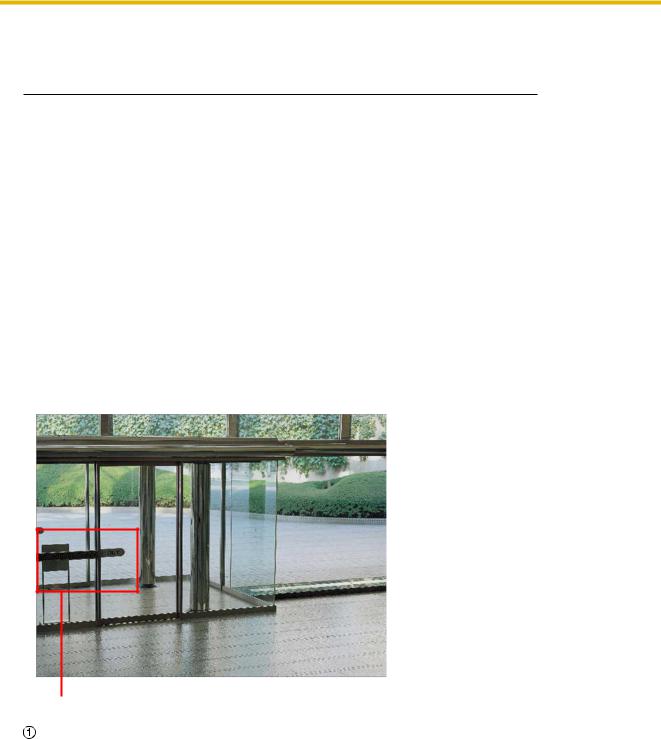
1 Monitor images on a PC
*1
*2
*3
*4
•Depending on the PC in use, screen tearing* may occur when the shooting scene drastically changes due to the GDI restrictions of the OS.
*A phenomenon in which portions of the screen are displayed out of alignment.
Only operable by users whose access level is “1. Administrator”. Used by super resolution techniques.
Only operable by users whose access level is “1. Administrator” or “2. Camera control” when “On” is selected for “User auth.” (®page 139)
Operable by users who belong to the access level selected for “Permission level of audio trans./recep.” on the [Audio] tab of the “Image/Audio” page. Refer to page 111 for the permission level of audio.
1.3 Monitor cropping images
Full angle images and cropping images can be transmitted at the same time.
The cropping function must be configured in order to transmit cropping images. (®page 136)
Either one of H.264(1), H.264(2), H.264(3), H.264(4), JPEG(1), JPEG(2), or JPEG(3) images or all of H. 264(1), H.264(2), H.264(3), and H.264(4) images can be set as cropping images.
By matching the settings of the [Compression] and [Stream]/[Image capture size] buttons on the “Live” page to the stream selected in “Cropping” on the [Cropping] tab, cropping images will be displayed on the [Cropping] display of the “Live” page and the main area.
Cropping
A
You can crop areas that you want to monitor.
By setting multiple cropping areas, up to 4 areas can be displayed in a sequence.
Operating Instructions |
13 |
|
|
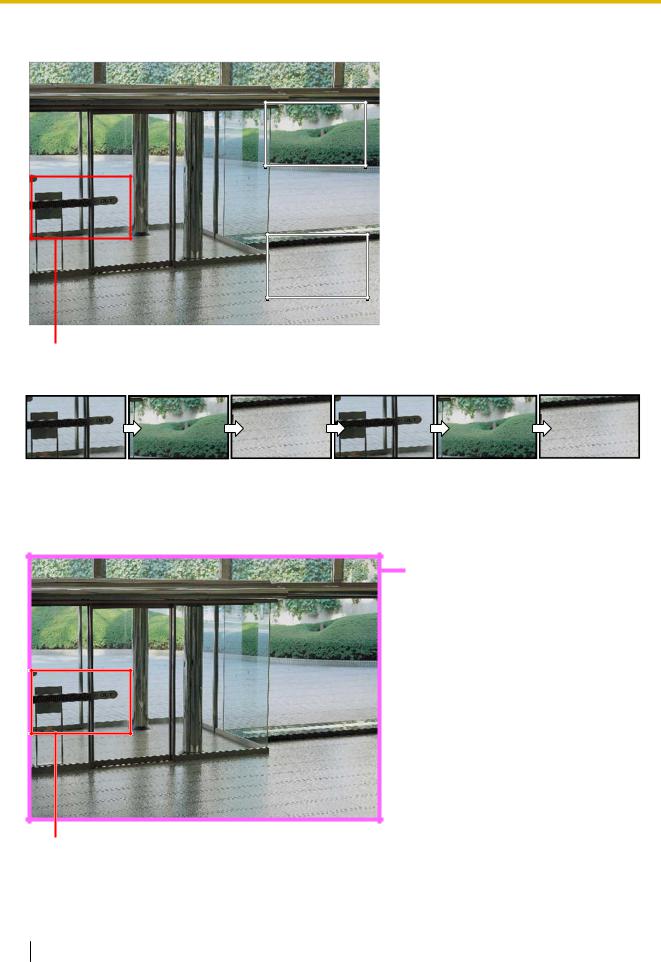
1 Monitor images on a PC
Sequence display using the cropping function
 B
B
 C
C
A
A B C A B C
By selecting the cropping areas for alarm actions, the area you want to monitor (home area) when alarm occurs can be displayed.
Sequence display using the alarm action cropping function
B
A
14 Operating Instructions

1 Monitor images on a PC
A B
B  A A A B
A A A B
A.Alarm occurrence
B.Time while the cropping area is displayed
Note
•Alarm action cropping can only be used when a setting other than “H.264(all)” is selected for “Cropping”. (®page 136)
Operating Instructions |
15 |
|
|
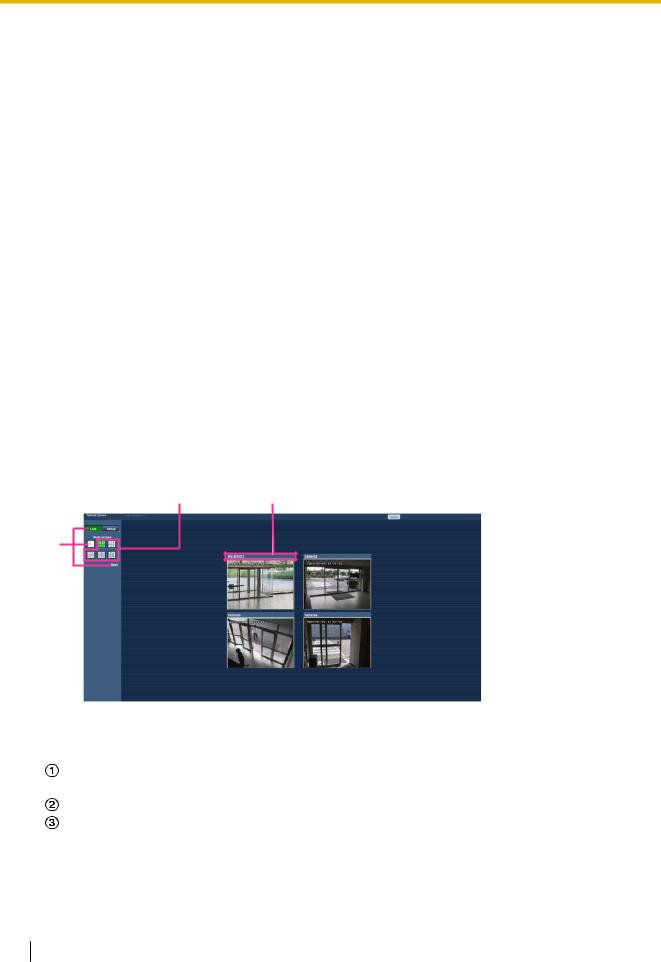
1 Monitor images on a PC
1.4 Monitor images from multiple cameras
Images from multiple cameras can be displayed on a multi-screen. Images from 4 cameras (up to 16 cameras) can be displayed simultaneously. To display images on a multi-screen, it is necessary to register cameras in advance. 4 cameras can be registered as a group and up to 4 groups (16 cameras) can be registered.
(®page 114)
IMPORTANT
•When displaying images on a 16-screen, panning, tilting and zooming operations become unavailable for images from cameras with Pan/Tilt/Zoom functions.
•When the power is turned off or the LAN cable is disconnected while displaying images, displaying images on a multi-screen from the “Live” page will become unavailable.
Note
•When displaying images on a 4-screen, panning, tilting and zooming operations become available only for images from cameras with Pan/Tilt/Zoom functions. Refer to our website (http://security.panasonic.com/pss/security/support/info.html) for further information about the compatible cameras and their versions.
•Only JPEG images can be displayed on a multi-screen. Audio will not be heard.
•When displaying the image on a multi-screen and “16:9” is selected for the aspect ratio, the image will be displayed altered vertically to the aspect ratio of “4:3”.
•“Network Camera Recorder with Viewer Software Lite” which supports live monitoring and recording images from multiple cameras is available. For further information, refer to our website (http://security.panasonic.com/pss/security/support/info.html).
1.Click the desired [Multi-screen] on the “Live” page.
→ Images from the registered cameras will be displayed on a selected multi-screen (screen can be split up to 16 areas). The following are instructions when displaying on a 4-split screen.
B C
WV-SPN311 WV-SPN311
A
To show 1 camera screen, click the [Live] button.
You can also click “1” below “Multi-screen” or “Back” to display the camera's “Live” page.
Click the [Multi-screen] button to display images from cameras in a multi-screen of 4 to 16 screens.
Click a camera title. Live images from the camera corresponding to the clicked camera title will be displayed on the “Live” page of the newly opened window.
16 Operating Instructions

2 Monitor images on a cellular phone/mobile terminal
2 Monitor images on a cellular phone/mobile terminal
2.1 Monitor images on a cellular phone
It is possible to connect to the camera using a cellular phone via the Internet and monitor images (MJPEG or JPEG) from the camera on the screen of the cellular phone.
IMPORTANT
•When the authentication window is displayed, enter the user name and password. The default user name and password are as follows.
User name: admin Password: 12345
To enhance the security, change the password for the user “admin”. (®page 139)
•If the cellular phone in use is not compatible with UTF-8 encode, it is impossible to display the screen correctly.
•When “VGA”, “QVGA”, “640x360”, or “320x180” is not selected one time or more for either one of “JPEG(1)”, “JPEG(2)”, or “JPEG(3)” of [JPEG] on the [JPEG/H.264] tab, images cannot be viewed from cellular phones.
Note
•It is necessary to configure the network settings of the cellular phone in advance to connect to the Internet and monitor images from the camera. (®page 144)
•When “Auto” is selected for “Language”, the screen is displayed in English. If you want the screen to be displayed in Japanese or Chinese, select “Japanese” or “Chinese” for “Language”. (®page 47)
Operating Instructions |
17 |
|
|

2 Monitor images on a cellular phone/mobile terminal
1.Access to “http://IP address/mobile”*1 or “http://Host name registered in the DDNS server/mobile” using a cellular phone.
→ Images from the camera will be displayed.
WV-SPN311
A
B
C
D
Refresh control
Press the dial key “5” or the [Manual Refresh] button to refresh the camera images.
Press the [Auto Refresh] button to refresh the images from the camera in 5-second intervals.
When the dial key “5” or the [Manual Refresh] button is pressed again, the refresh mode of the camera will return to manual refresh.
IMPORTANT
•Transmission will be periodically performed when “Auto Refresh” is selected for the camera image. Confirm the contract plan of the cellular phone in use before using this function.
•Depending on the cellular phone in use, “Auto Refresh” may be unavailable.
Resolution control
Changes the image capture size by pressing the dial key “0”.
•Image in the aspect ratio of “4:3”: Changes the image capture size between 320x240 (default) and 640x480.
•Image in the aspect ratio of “16:9”: Changes the image capture size between 320x180 (default) and 640x360.
Image quality control
It is possible to change the image quality between “Quality1” and “Quality2”. (®page 84)
AUX control*2
Controls the AUX terminal.
These buttons will be displayed only when “AUX output” is selected for “Terminal 3” on the setup menu. (®page 116)
18 Operating Instructions

2 Monitor images on a cellular phone/mobile terminal
Note
•Some cellular phones cannot change the image capture size even when resolution is changed by resolution control.
•Depending on the image capture size selected for “JPEG(1)”, “JPEG(2)”, or “JPEG(3)”, “Resolution” may not be able to be used.
•When the HTTP port number is changed from “80”, enter “http://IP address: (colon) + port number/ mobile”*1 in the address box of the browser. When using the DDNS function, access to “http://Host name registered in the DDNS server: (colon) + port number/mobile”.
•When “HTTPS” is selected for “HTTPS” - “Connection” on the [Advanced] tab of the “Network” page, enter as follows.
“https://IP address: (colon) + port number/mobile” or “https://Host name registered in the DDNS server: (colon) + port number/mobile”
•When the authentication window is displayed, enter the user name of an administrator or user and password. Depending on the cellular phone in use, password entry may be required each time the screen is switched.
•It is impossible to transmit/receive audio using a cellular phone.
•Depending on the cellular phone in use, larger size images may not be displayed. In this case, selecting “9 Low” for “Image quality setting” of “JPEG” (®page 84) may sometimes solve this problem.
•Depending on the cellular phone in use or its contract plan, it may be impossible to access.
*1
*2
IP address is the global WAN IP address of the router that can be accessed via the Internet.
When “User auth.” is set to “On” (®page 139), only users with the access level of “1. Administrator” or “2. Camera control” will be displayed.
2.2 Monitor images on a mobile terminal
It is possible to connect to the camera using a mobile terminal via the Internet and monitor images (MJPEG or JPEG) from the camera on the screen of the mobile terminal. It is also possible to refresh images to display the latest image.
The compatible mobile terminals are shown as follows. (As of July, 2014)
–iPad, iPhone, iPod touch (iOS 4.2.1 or later)
–Android™ mobile terminals
When an Android terminal is used, an MJPEG format image is displayed by the Firefox® browser, but a JPEG format image is displayed by the standard browser.
For further information about compatible devices, refer to our website (http://security.panasonic.com/pss/security/support/info.html).
IMPORTANT
•When the authentication window is displayed, enter the user name and password. The default user name and password are as follows.
User name: admin Password: 12345
To enhance the security, change the password for the user “admin”. (®page 139)
Note
•It is necessary to configure the network settings of the mobile terminal in advance to connect to the Internet and monitor images from the camera. (®page 144)
Operating Instructions |
19 |
|
|
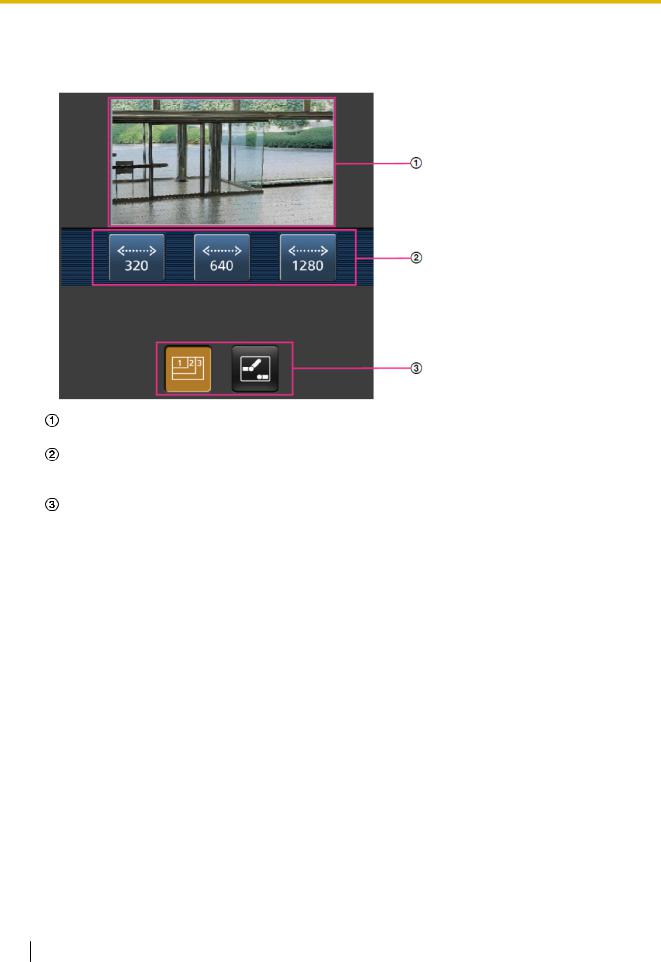
2 Monitor images on a cellular phone/mobile terminal
1.Access to “http://IP address/cam”*1 or “http://Host name registered in the DDNS server/cam” using a mobile terminal.
→ Images from the camera will be displayed.
Live images area
Displays images from the camera.
Operation buttons area
When functions are selected in the function selection area C, buttons to operate those functions are displayed.
Function selection area
When functions that can be operated are selected, operation buttons are displayed in the operation buttons area B.
20 Operating Instructions

2 Monitor images on a cellular phone/mobile terminal
2. Click the button of the function that you want to operate.
A B
Resolution control
AUX control
Each function is explained below.  Resolution control
Resolution control
Press the  button to display the buttons used to select the resolution on the screen.
button to display the buttons used to select the resolution on the screen.
The resolution can be changed by selecting a resolution setting from the buttons.
Images are displayed in the image capture size selected in “JPEG(1)”, “JPEG(2)”, or “JPEG(3)” of [JPEG] on the [JPEG/H.264] tab.
Operating Instructions |
21 |
|
|
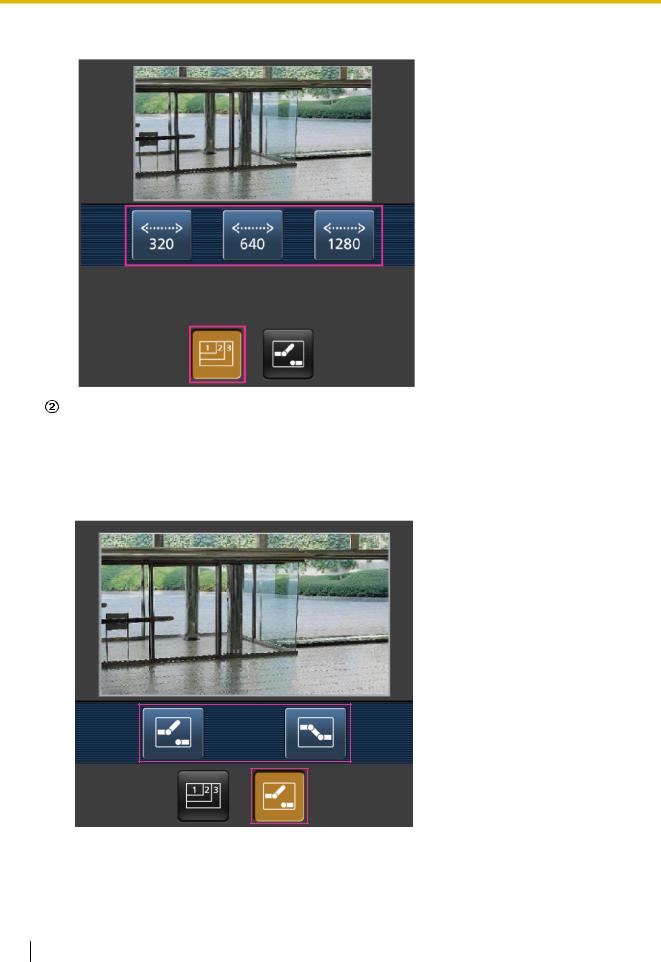
2 Monitor images on a cellular phone/mobile terminal
AUX control
Press the  button to display the buttons used to operate the AUX output on the screen. The AUX output terminals can be controlled with the
button to display the buttons used to operate the AUX output on the screen. The AUX output terminals can be controlled with the  and
and  buttons.
buttons.
This function is only displayed when [Terminal 3] is set to [AUX output] on the settings menu. (®page 116)
Note
•You can change the image size displayed on the mobile terminal by accessing the following addresses.
– Large display: http://IP address/cam/dl
22 Operating Instructions

2 Monitor images on a cellular phone/mobile terminal
–Medium display: http://IP address/cam/dm
–Small display: http://IP address/cam/ds
•When the resolution is changed by the resolution control, the displayed resolution changes but the image size remains the same.
•When the HTTP port number is changed from “80”, enter “http://IP address: (colon) + port number/ cam”*1 in the address box of the browser. When using the DDNS function, access to “http://Host name registered in the DDNS server: (colon) + port number/cam”*2.
•When “HTTPS” is selected for “HTTPS” - “Connection” on the [Advanced] tab of the “Network” page, enter as follows.
“https://IP address: (colon) + port number/cam” or “https://Host name registered in the DDNS server: (colon) + port number/cam”
•When the authentication window is displayed, enter the user name of an administrator or user and password. Depending on the mobile terminal in use, password entry may be required each time the screen is switched.
•It is impossible to transmit/receive audio using a mobile terminal.
•Depending on the mobile terminal in use, larger size images may not be displayed. In this case, selecting “9 Low” for “Image quality setting” of “JPEG” (®page 84) may sometimes solve this problem.
•Depending on the mobile terminal in use or its contract plan, it may be impossible to access.
*1
*2
IP address is the global WAN IP address of the router that can be accessed via the Internet. However, when accessing the same LAN as the camera with a wireless compatible mobile terminal, the IP address is the local IP address.
Only when accessing the camera via the Internet.
Operating Instructions |
23 |
|
|

3 Record images on the SD memory card manually
3 Record images on the SD memory card manually
Images displayed on the “Live” page can be recorded on the SD memory card manually. This button is operable only when “Manual” is selected for “Save trigger” on the [SD memory card] tab on the “Basic” page of the setup menu. (®page 56)
It is possible to select “JPEG(1)”, “JPEG(2)”, “JPEG(3)”, “H.264(1)”, “H.264(2)”, “H.264(3)”, or “H.264(4)” on “Recording format” of the setup menu. (®page 53) When “JPEG” is selected for “Recording format”, still image data are recorded. When “H.264(1)”, “H.264(2)”, “H.264(3)”, or “H.264(4)” is selected, video data are recorded.
Images recorded on the SD memory card can be copied onto the PC. (®page 70) 1. Display the “Live” page. (®page 7)
2.Click the [SD] button.
→ The SD recording window will open.
3.Click the [Start] button to start recording images on the SD memory card. The SD recording status indicator will light red (®page 9) while images are being recorded on the SD memory card.
The image saving interval can be configured on the [SD memory card] tab of the “Basic” page. (®page 56)
4.Click the [Stop] button to stop saving images on the SD memory card. ® The SD recording status indicator will turn off.
5.Click the [Close] button to close the window.
Note
•Image data saved on Drive B can be obtained by executing “Access img.” on the [SD memory card] tab and logging in from the user authentication window (®page 70).
The destination to save image data is a fixed directory on Drive B (®page 216).
24 Operating Instructions

3 Record images on the SD memory card manually
•When the [Start] button is clicked immediately after the [Stop] button is clicked, saving of images may not start. In this case, click the [Start] button again.
Operating Instructions |
25 |
|
|

4 Action at an alarm occurrence
4 Action at an alarm occurrence
The alarm action (camera action at an alarm occurrence) will be performed when the following alarms occur.
4.1 Alarm type
• Terminal alarm: When connecting an alarm device such as a sensor to the alarm input terminal of the camera, the alarm action will be performed when the connected alarm device is activated.
• VMD alarm: When motion is detected in the set VMD area, the alarm action will be performed. *VMD stands for “Video Motion Detection”.
• Command alarm: When a Panasonic alarm protocol is received from the connected device via a network, the alarm action will be performed.
• Audio detection alarm: When the configured audio detection level is exceeded, the alarm action will be performed.
4.2 Action at an alarm occurrence
Display the alarm occurrence indication button on the “Live” page
The alarm occurrence indication button will be displayed on the “Live” page at an alarm occurrence. (®page 9)
IMPORTANT
•When “Polling(30s)” is selected for “Alarm status update mode” (®page 47), the Alarm occurrence indication button will be refreshed in 30-second intervals. For this reason, it may take a maximum of 30 seconds until the alarm occurrence indication button is displayed on the “Live” page at an alarm occurrence.
Notify of alarm occurrences to the device connected to the alarm connector
It is possible to output signals from the alarm output terminal of the camera and sound the buzzer when an alarm occurs. The settings for the alarm output can be configured in the “Alarm output terminal setup” section of the [Alarm] tab of the “Alarm” page. (®page 118)
Save images on the SD memory card
When an alarm occurs, images (JPEG/H.264) will be saved on the SD memory card. The settings to save images on the SD memory card can be configured on the [SD memory card] tab (®page 53) of the “Basic” page and the [Alarm] tab of the “Alarm” page. (®page 119)
Transmit an image onto a server automatically
An alarm image can be transmitted at an alarm occurrence to the server designated in advance. The settings required to transmit an alarm image to a server can be configured in the “Alarm image” section on the [Alarm] tab of the “Alarm” page (®page 119) and the [Advanced] tab of the “Network” page (®page 152).
26 Operating Instructions

4 Action at an alarm occurrence
Notify of alarm occurrences by E-mail
Alarm E-mail (alarm occurrence notification) can be sent at an alarm occurrence to the E-mail addresses registered in advance. Up to 4 addresses can be registered as recipients of the alarm E-mail. An alarm image (still picture) can be sent with the alarm E-mail as an attached file. The settings for alarm E-mail can be configured in the “E-mail notification” section on the [Alarm] tab of the “Alarm” page (®page 119) and the [Advanced] tab of the “Network” page (®page 149).
Notify of alarm occurrences to the designated addresses (Panasonic alarm protocol notification)
This function is available only when a Panasonic device, such as the network disk recorder, is connected to the system. When “On” is selected for “Panasonic alarm protocol notification”, the connected Panasonic device will be notified that the camera is in the alarm state. The settings for Panasonic alarm protocol can be configured in the Panasonic alarm protocol section of the [Notification] tab of the “Alarm” page. (®page 132)
Notify of alarm occurrences to the designated HTTP server (HTTP alarm notification)
Alarm occurrence notifications can be sent at an alarm occurrence to the HTTP servers registered in advance. Up to 5 HTTP servers can be registered as recipients of alarm notifications. The URL sent to HTTP servers with alarm notifications can be specified. The settings for HTTP alarm notification can be configured on the [Notification] tab of the “Alarm” page. (®page 134)
Operating Instructions |
27 |
|
|

5 Transmit images onto an FTP server
5 Transmit images onto an FTP server
Images can be transmitted to an FTP server. By configuring the following settings, transmission of images captured at an alarm occurrence or captured at a designated interval to an FTP server will become available.
IMPORTANT
•When using this function, set the user name and the password to access the FTP server to restrict users who can log into the FTP server.
5.1Transmit an alarm image at an alarm occurrence (Alarm image transmission)
An alarm image can be transmitted at an alarm occurrence to the FTP server. To transmit alarm images to an FTP server, it is necessary to configure the settings in advance.
FTP server settings and settings relating to alarm image transmission can be configured in the “FTP” section of the [Advanced] tab of the “Network” page. (®page 152) Settings can also be configured from the “Alarm image FTP transmission” settings of “Camera action on alarm” on the [Alarm] tab of the “Alarm” page. (®page 119)
Note
•Depending on the network traffic, the number of the transmitted images may not reach the set number of images to be transmitted.
•Alarm images failed to be transmitted to the FTP server at an alarm occurrence will not be saved on the SD memory card. However, images that fail to be transmitted with the FTP periodic image transmission will be saved.
When “On” is selected for both the alarm image transmission function and the FTP periodic image transmission function, the alarm image transmission function will be given priority over the FTP periodic image transmission function. Also, when “On” is selected for the “FTP transmission retry” FTP setting (®page 153), alarm images will be retransmitted if there is an FTP transmission failure. Therefore, if there is continuous retransmission due to network problems or other factors, periodic transmission will not be performed and images that fail to be transmitted with the FTP periodic image transmission will not be saved to an SD memory card.
5.2Transmit images at a designated interval or period (FTP periodic image transmission)
Images can be transmitted at a designated interval or period. To transmit images at a designated interval or period, it is necessary to configure the settings in advance.
FTP server settings and settings relating to FTP periodic transmission image transmission can be configured in the “FTP” section of the [Advanced] tab of the “Network” page. (®page 152)
Configure the schedule settings of the FTP periodic image transmission on the “Schedule” page.
Note
•Depending on the line speed or the traffic, images may not be transmitted at the designated interval.
•When “On” is selected for both the alarm image transmission function and the FTP periodic image transmission function, the alarm image transmission function will be given priority over the FTP periodic image transmission function. Therefore, images may not be transmitted at the interval designated on the “FTP periodic image transmission” setting.
28 Operating Instructions

5 Transmit images onto an FTP server
5.3 Save images on the SD memory card when images fail to transmit using the FTP periodic image transmission function
Images that have failed to transmit using the FTP periodic image transmission can be saved automatically on the SD memory card. It is possible to select a trigger to save images on the SD memory card on the [SD memory card] tab of the “Basic” page. (®page 53)
To use the SD memory recording function featured in Panasonic network disk recorder, select “Off” for “FTP periodic image transmission” (®page 154) and “FTP error” for “Save trigger” of “Recording stream
1” (®page 56).
Note
•When “On” is selected for both the alarm image transmission function and the FTP periodic image transmission function, the alarm image transmission function will be given priority over the FTP periodic image transmission function. Also, when “On” is selected for the “FTP transmission retry” FTP setting (®page 153), alarm images will be retransmitted if there is an FTP transmission failure. Therefore, if there is continuous retransmission due to network problems or other factors, periodic transmission will not be performed and images that fail to be transmitted with the FTP periodic image transmission will not be saved to an SD memory card.
IMPORTANT
•We make no guarantee for any damages of files on the SD memory card incurred by malfunction or error occurrence in files saved in the SD memory card regardless of what the cause may be.
Operating Instructions |
29 |
|
|

6 Display the log list
6 Display the log list
The history of various logs will be displayed in list form.
•Alarm log: Logs of the alarm occurrences such as time and date of the alarm occurrences, the image recording period and the alarm type will be displayed.
•Manual/Schedule log: Logs filed when images have been recorded manually or during the period of the schedule, and the image recording period will be displayed.
•FTP trans. error log: Logs filed when the FTP periodic image transmission function has failed will be displayed.
1. Display the “Live” page.
30 Operating Instructions
